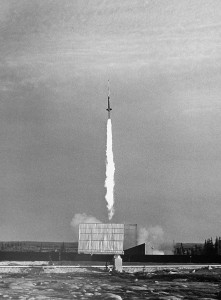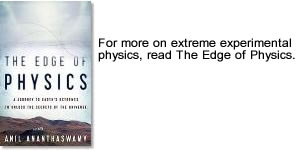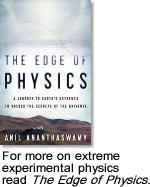Category — History
From nearly winning the Nobel to farming in Italy

IT WAS TWENTY YEARS AGO TODAY…
Apologies to the Beatles, but it was twenty years ago in January 1990, that Herb Gush, a physicist at the University of British Columbia, performed a landmark measurement of the cosmic microwave background using a rocket-based experiment. Had fate sided with him and had he launched the rocket a few months earlier, Gush would have won the Nobel Prize for accurately measuring the spectrum of the CMB. Instead, he became the first to independently confirm the measurements made by NASA’s Cosmic Background Explorer (COBE) satellite, for which John Mather and George Smoot won the Nobel in 2006.
The same month that Gush launched his rocket from White Sands, New Mexico, John Mather received a standing ovation at the meeting of the American Astronomical Society in Crystal City, Virginia. His experiment on COBE had shown that the radiation leftover from the big bang had exactly the spectrum expected of black-body radiation. It was a stunning confirmation of the big bang theory.
Gush almost beat Mather to the first indisputable measurement of the CMB spectrum (after the initial discovery by Penzias and Wilson in 1965). Gush had been using rockets to launch spectrometers hundreds of kilometers into space since the 1970s. But his earlier attempts with prototype spectrometers were unsuccessful as the payload failed to stay clear of the rocket’s exhaust, messing up the measurements.
Then , in the late 1980s, Gush and graduate students Ed Wishnow and Mark Halpern were ready with a sophisticated instrument that compared the CMB spectrum with the spectrum of an on-board blackbody radiator. But in the fall of 1989, the device was damaged by the malfunctioning of a vibrator in a vibrator test before launch.
The time it took for repairs meant that the rocket launch was delayed until late January 1990. When it was finally sent up, the experiment was a success. “It was immediately clear that the spectrum was near Planckian with a temperature near 2.7K,” said Gush in an email to me in 2007.
But as luck would have it, COBE had already made the measurement. If the roles had been reversed, COBE would have confirmed Gush’s data and not the other way around. Of course, this doesn’t take anything away from COBE, which was an exquisite experiment.
Just goes to show how small the margin can be between being the first to a discovery and the second.
Gush, for his part, retired and took up farming near Palermo, Italy.
When I met cosmologist James Peebles of Princeton in 2007 for my book The Edge of Physics, Peebles was still a bit miffed that Gush didn’t share the Nobel with Mather and Smoot. “There should be a list of great measurements that were underappreciated,” he told me. “Gush was working on that experiment for more than 15 years. COBE was under development for the same length of time, and they got first data within 2 months of each other. Mather in his book is very explicit – Gush could have scooped us, and would have been famous. Instead young people don’t even know his [Gush’s] name.”
Well, here’s to Gush and his brilliant experiment.
March 2, 2023 No Comments
Tales of Russian ingenuity

Ice Fishing for neutrinos on a frozen Lake Baikal
WE HAVE ALL HEARD OF HOW NASA spend millions (or is it billions) on developing a pen that works in zero gravity, while the Russians used a pencil. A classic case of Russian ingenuity, it seemed, until it was exposed as an urban legend.
Russian ingenuity, however, is not a myth. I got to experience it first-hand while writing The Edge of Physics. One of the many trips I made for the book was to see the Lake Baikal Neutrino Telescope near Irkutsk, in Southern Siberia. The telescope is essentially long “strings” of photomultiplier tubes (PMTs) that are submerged more than a kilometer beneath the surface of the lake. PMTs can be thought of as the opposite of television tubes. A TV tube generates photons from electrical signals, while a PMT generates electrical signals from photons that hit its surface. The PMTs deep in the waters of Lake Baikal are looking for the blue Cherenkov light that is emitted when a neutrino hits a molecule of water.
So, where does Russian ingenuity come in? Well, for starters, they have figured out a way of deploying these detectors without the use of expensive ships and submersibles (as they do for the neutrino telescopes being built in the Mediterranean Sea). The Russians wait for Lake Baikal to freeze over, and then during the peak of the Siberian Winter, they establish an ice camp on top of the frozen lake. They bring their cranes and winches and the like, haul out their telescope from the depths of Lake Baikal, do the necessary maintenance and repairs, and get out of there before the ice melts.
Using this unusual and extremely hazardous mode of operation, they have managed to build the world’s first underwater neutrino telescope and run it for twenty years with only about $20 million. The other neutrino detectors, either underwater or embedded in the ice (such as at the South Pole), are costing hundreds of millions of dollars.
But the most telling illustration of Russian ingenuity – of course, necessitated by lack of resources sometimes, but worth appreciating regardless – was to do with the retrieval of a string that got cut one winter and sank to the bottom of the lake. Here’s a description of it from The Edge of Physics:
- The Lake Baikal neutrino telescope is made of eleven strings of photomultiplier tubes—each with a large buoy at the top and a counterweight at the bottom—that float nearly 1.1 kilometers below the surface (the water here is a staggering 1.4 kilometers deep, enough for a building three times as tall as New York’s Empire State to sink without a trace). Smaller buoys attached to the strings float about 10 meters below the surface. All year round, a total of 228 PMTs watch for the Cherenkov light created by neutrinos, monitoring 40 megatons of water. Each winter, once the ice camp has been set up, the team has to locate the telescope, the upper part of which drifts slightly over the course of the year. A diver plunges into the ice-cold water to locate the small buoy fixed to the center of the telescope. Then the researchers cut holes in the ice above each string (whose positions they know relative to the center) and attach a winch to the small buoys to haul up the strings. The team has two months to carry out any routine maintenance, put the strings back in the water, and get out before the ice cracks. They have perfected their technique; only once in two decades of operation did they have a problem retrieving a string. In 1994, a rusty metal cable broke, severing the buoy from its string, causing the string to sink to the bottom.
- Physicist Nikolai Budnev retrieved it. Diving that deep was out of the question, but Budnev knew that the string—though its counterweight was on the lake bed—would still be vertical because of the buoyancy of the PMTs. What he did next was ingenious. He fashioned a propeller and tied it to the end of a long rope, dropping the propeller into the water. The angle of the blades was such that as the propeller sank it started rotating, making huge circles. Budnev used this simple tool to sweep the waters below. Soon, the propeller snagged the errant string, and the team pulled it up.
I can confidently say that the Russians (and the Germans who worked alongside them) at Lake Baikal are amongst the toughest bunch of physicists I have encountered.
Here are some pictures of my trip to Lake Baikal.
March 1, 2023 No Comments



